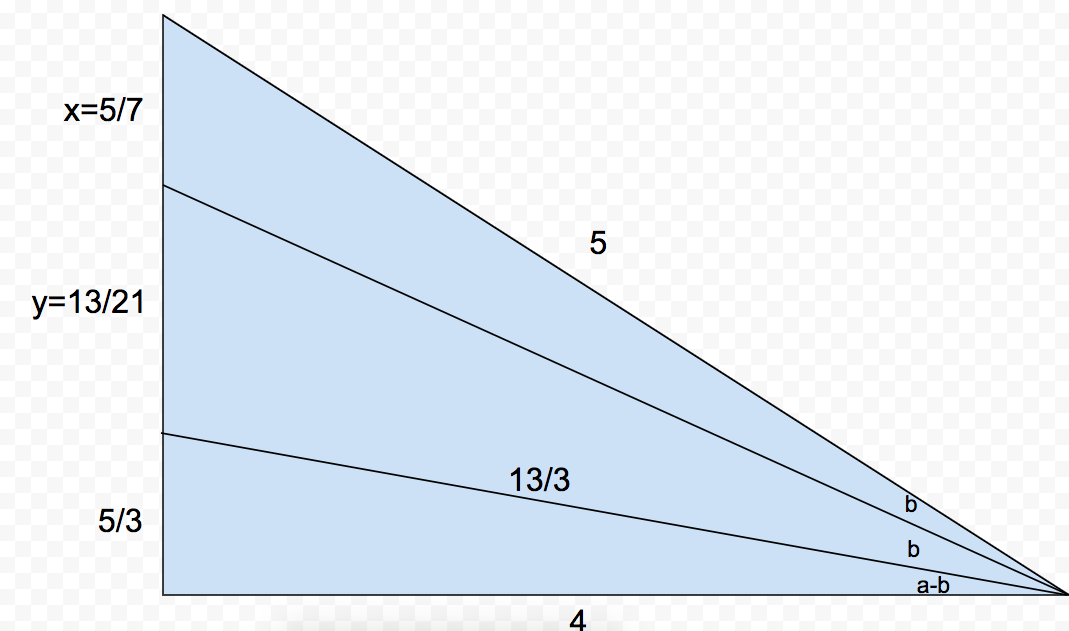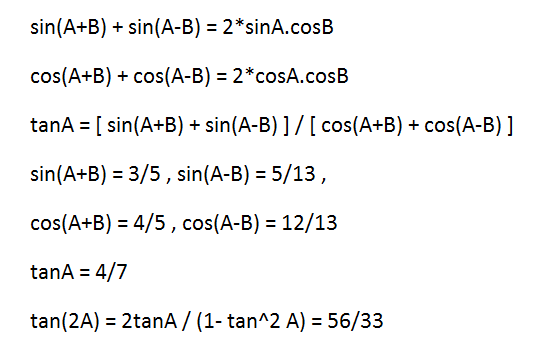Trigonometry
Let A and B be angles in the interval 0 ∘ < A , B < 4 5 ∘ . If cos ( A + B ) = 5 4 and sin ( A − B ) = 1 3 5 , find the value of tan 2 A .
This section requires Javascript.
You are seeing this because something didn't load right. We suggest you, (a) try
refreshing the page, (b) enabling javascript if it is disabled on your browser and,
finally, (c)
loading the
non-javascript version of this page
. We're sorry about the hassle.
8 solutions
cos ( A + B ) ⟹ tan ( A + B ) 1 − tan A tan B tan A + tan B 4 tan A + 4 tan B ⟹ tan B = 5 4 Given = 4 3 = 4 3 = 3 − 3 tan A tan B = 4 + 3 tan A 3 − 4 tan A
sin ( A − B ) ⟹ tan ( A − B ) 1 + tan A tan B tan A − tan B 1 2 tan A − 1 2 tan B ⟹ tan B = 1 3 5 Given = 1 2 5 = 1 2 5 = 5 + 5 tan A tan B = 1 2 + 5 tan A 1 2 tan A − 5
⟹ 4 + 3 tan A 3 − 4 tan A ( 3 − 4 tan A ) ( 1 2 + 5 tan A ) 3 6 − 3 3 tan A − 2 0 tan 2 A 5 6 tan 2 A + 6 6 tan A − 5 6 2 8 tan 2 A + 3 3 tan A − 2 8 ( 7 tan A − 4 ) ( 4 tan A + 7 ) ⟹ tan A = 1 2 + 5 tan A 1 2 tan A − 5 = ( 1 2 tan A − 5 ) ( 4 + 3 tan A ) = 3 6 tan 2 A + 3 3 tan A − 2 0 = 0 = 0 = 0 = 7 4 Since 0 ∘ < A < 4 5 ∘
⟹ tan 2 A = 1 − 4 9 1 6 7 8 = 3 3 5 6
cos ( A + B ) = 5 4 ⟹ A + B = cos − 1 ( 5 4 ) ......(1)
sin ( A − B ) = 1 3 5 ⟹ A − B = sin − 1 ( 1 3 5 ) ......(2)
(1) + (2) ⟹ 2 A = cos − 1 ( 5 4 ) + sin − 1 ( 1 3 5 )
Therefore,
tan 2 A = tan ( cos − 1 ( 5 4 ) + sin − 1 ( 1 3 5 ) ) = 1 − tan ( cos − 1 ( 5 4 ) ) tan ( sin − 1 ( 1 3 5 ) ) tan ( cos − 1 ( 5 4 ) ) + tan ( sin − 1 ( 1 3 5 ) ) = 1 − ( 4 3 ) ( 1 2 5 ) 4 3 + 1 2 5 = 1 − 4 8 1 5 6 7 = 3 3 5 6
OR
cos ( A + B ) = 5 4 ⟹ tan ( A + B ) = 4 3 sin ( A − B ) = 1 3 5 ⟹ tan ( A − B ) = 1 2 5
tan 2 A = tan ( ( A + B ) + ( A − B ) ) = 1 − tan ( A + B ) tan ( A − B ) tan ( A + B ) + tan ( A − B ) = 1 − ( 4 3 ) ( 1 2 5 ) 4 3 + 1 2 5 = 1 − 4 8 1 5 6 7 = 3 3 5 6
Here is a geometric way to solve the problem:

Here, the values of ( x ) and ( y ) are derived from a system of equations with the angle bisector theorem and the fact that ( x + y + 1 . 6 6 6 7 ) = 3 by the Pythagorean theorem. The values ( 3 1 3 )) and ( 3 5 )) are derived from the fact that the Triangle with those lengths is a 5 − 1 2 − 1 3 triangle dilated with a factor of 0 . 3 3 3 since 1 2 ∗ 0 . 3 3 3 = 4 , and 1 2 is derived from a 5 − 1 2 − 1 3 triangle as s i n ( a − b ) = ( 1 3 5 )).
Next, using t a n ( A ) = ( 7 4 )), then t a n ( 2 A ) can be evaluated using substitution and the tan double angle formula.
Applying product-to-sum identities, we have thee following:
cos ( A + B ) cos ( A − B ) = 6 5 4 8 , ( 1 a )
sin ( A + B ) sin ( A − B ) = 6 5 1 5 , ( 1 b )
sin ( A + B ) cos ( A − B ) = 6 5 3 6 , ( 2 a )
cos ( A + B ) sin ( A − B ) = 6 5 2 0 . ( 2 b )
Subtract ( 1 a ) and ( 1 b ) , and add ( 2 a ) and ( 2 b ) respectively yields
cos ( A + B ) cos ( A − B ) − sin ( A + B ) sin ( A − B ) = 6 5 3 3 = cos ( 2 A ) , ( 3 )
sin ( A + B ) cos ( A − B ) + cos ( A + B ) sin ( A − B ) = 6 5 5 6 = sin ( 2 A ) . ( 4 )
Divide ( 4 ) and ( 3 ) gives
tan ( 2 A ) = cos ( 2 A ) sin ( 2 A ) = 3 3 5 6 .
Note : cos ( A − B ) = 1 3 1 2 and sin ( A + B ) = 5 3 .
Sin(A+B. + A - B) = sin (2A) Sin(A + B + A- B) = Sin(A+B)cos(A-B) + cos(A+B)sin(A-B) cos(A + B) = 4/5 so sin(A + B) = 3/5 sin(A-B) = 5/13 so cos(A-B) = 12/13 sin(2A) = 3/5 × 12/13 + 4/5 × 5/13 = 56/65 So cos(2A) = 33/65 Therefore tan(2A) =56/65 ÷ 33/65 = 56/33
Easy ... Like whi dont know that..this is old school . dont even need to calculateur that you can JUST do a quick resolution in your head
Inverse sin(5/13) = 22.62 degrees = A - B
Inverse cos(4/5) = 36.87 degrees = A + B
Adding two equations yields: 59.49 degrees = 2 *A
Tan(59.49) = 1.697 = 56/33
